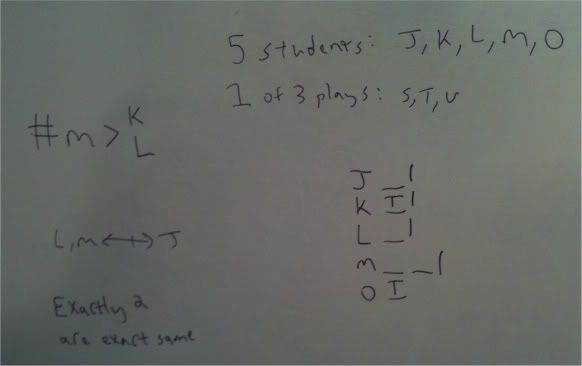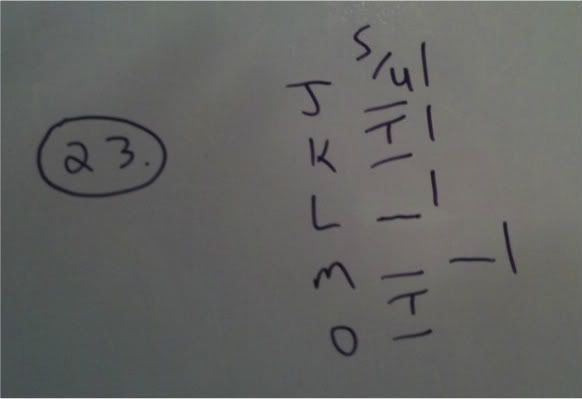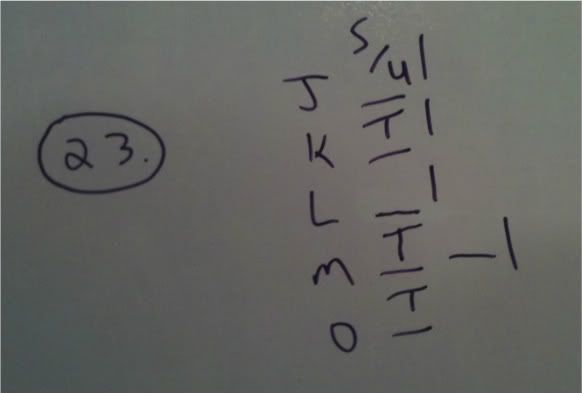I get the main diagram, but i'm still not sure about question 22 and 23.
can you explain these?
LSAT Forum
2 postsPage 1 of 1
-

- timmydoeslsat
-
Thanks Received: 887
-
Atticus Finch

- Posts: 1136
- Joined: June 20th, 2011

- Most Thanked

- First Responder
Re: Q22
This can be used as a global diagram for this game.

I realize you said that you understand the main diagram, but I will go over key points of it that are critical in answer #22 and #23.
It is important to realize that when J is assigned a certain variable, M will get the other 2 variables. L will be assigned one of those variables that M has, but in the global scheme of the game, it is now certain which it will be.
A key rule to keep in mind is the last rule in this game. This rule can be translated to read as follows: Only two people will have the exact same play(s) in common.
Also important to realize that O has T, and there are really no rules governing what else O can have. As long as we keep in mind that 2 people must have an identical lineup, we can assign O whatever we want.
#22
You could choose to do this question after #23 since this question is global in nature and you could use a lot of the "if" questions (local questions) to build up hypotheticals that you could use to eliminate answer choices on this question.
We are asked which could be an accurate and complete list who have T. This is equivalent of asking us this: Can a hypothetical include these and only these variable T.
We know that K and O must have T because of the third rule.

As you can see, (A) and (E) are eliminated because they do not contain both K and O with T.
(B) (C) (D) are left. A common LSAT logic game situation.
Remember that this is not only an accurate list, but a COMPLETE list of the variables with T in a given scenario. I would recommend starting with the answer choices that have 3. Especially in this case that choice (B) with only 2 variables (K,O) will of course be right. (B) has an L, so let us try that.

We know that since two variables must be assigned to M, and since M is not included on this answer choice as having a T, then it must have S and U. However, with L having a T, that means that J cannot contain T. Since it cannot contain T, it must contain either S/U. But M and has both S and U! M, as well as L, cannot share ANY variables with J. This is impossible in this scenario! Eliminate.

So now we try M. We know that M has two variables that need assigning. The other variable must be either S or U. We know that since J cannot contain T in this case as it is not included on the list who contain T in this answer choice, then it must have either S or U. J will contain the opposite S/U option that T does. Since L and M do not contain any variables in common with J, then the choice that M makes on the S/U option will be the same choice that L will receive. I indicated this as boxing those two slots in to remind myself of this. As we can see, this is a valid scenario! This also means that B is not correct, as it is not a COMPLETE list, as we have shown that T can be with M in a scenario.
Also note, you could wall of O after just T to give a valid scenario to make only two students review the same plays. Or you could add the variable M has in the S/U option to the list that O has. In this scenario, O cannot review three plays.
#23

If J does not review T, then J must review either S or U. If it is the case that J must review one of those two variables, can it be possible for M to review BOTH S and U? Of course not! J and M, as well as L, cannot share any variables in common.

That means that M must choose the opposite of the S/U option that J has, and MUST have T to fill in that last spot in its two slots. To finish out this hypothetical, it is the same story as in the previous question. L must choose the same variable that M chooses in its S/U option. I boxed in that concept.


I realize you said that you understand the main diagram, but I will go over key points of it that are critical in answer #22 and #23.
It is important to realize that when J is assigned a certain variable, M will get the other 2 variables. L will be assigned one of those variables that M has, but in the global scheme of the game, it is now certain which it will be.
A key rule to keep in mind is the last rule in this game. This rule can be translated to read as follows: Only two people will have the exact same play(s) in common.
Also important to realize that O has T, and there are really no rules governing what else O can have. As long as we keep in mind that 2 people must have an identical lineup, we can assign O whatever we want.
#22
You could choose to do this question after #23 since this question is global in nature and you could use a lot of the "if" questions (local questions) to build up hypotheticals that you could use to eliminate answer choices on this question.
We are asked which could be an accurate and complete list who have T. This is equivalent of asking us this: Can a hypothetical include these and only these variable T.
We know that K and O must have T because of the third rule.

As you can see, (A) and (E) are eliminated because they do not contain both K and O with T.
(B) (C) (D) are left. A common LSAT logic game situation.
Remember that this is not only an accurate list, but a COMPLETE list of the variables with T in a given scenario. I would recommend starting with the answer choices that have 3. Especially in this case that choice (B) with only 2 variables (K,O) will of course be right. (B) has an L, so let us try that.

We know that since two variables must be assigned to M, and since M is not included on this answer choice as having a T, then it must have S and U. However, with L having a T, that means that J cannot contain T. Since it cannot contain T, it must contain either S/U. But M and has both S and U! M, as well as L, cannot share ANY variables with J. This is impossible in this scenario! Eliminate.

So now we try M. We know that M has two variables that need assigning. The other variable must be either S or U. We know that since J cannot contain T in this case as it is not included on the list who contain T in this answer choice, then it must have either S or U. J will contain the opposite S/U option that T does. Since L and M do not contain any variables in common with J, then the choice that M makes on the S/U option will be the same choice that L will receive. I indicated this as boxing those two slots in to remind myself of this. As we can see, this is a valid scenario! This also means that B is not correct, as it is not a COMPLETE list, as we have shown that T can be with M in a scenario.
Also note, you could wall of O after just T to give a valid scenario to make only two students review the same plays. Or you could add the variable M has in the S/U option to the list that O has. In this scenario, O cannot review three plays.
#23

If J does not review T, then J must review either S or U. If it is the case that J must review one of those two variables, can it be possible for M to review BOTH S and U? Of course not! J and M, as well as L, cannot share any variables in common.

That means that M must choose the opposite of the S/U option that J has, and MUST have T to fill in that last spot in its two slots. To finish out this hypothetical, it is the same story as in the previous question. L must choose the same variable that M chooses in its S/U option. I boxed in that concept.

2 posts Page 1 of 1